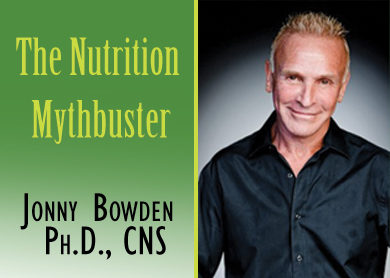Now, don’t get me wrong. I’m not an isolationist, anti-government radical. There are many things the government is set up to do quite well. Unfortunately, giving nutrition and health advice is not one of them. This may never change—at least in our lifetimes—which makes commenting on the new dietary guidelines a little like commenting on a new arrangement of deck chairs on the Titanic.
To understand why, it helps to know just a little about how the Dietary Guidelines are actually written—more specifically, who they’re written by.
The dietary guidelines are required every five years by something called the 1990 National Nutrition Monitoring and Related Research Act. The two government agencies charged with co-publishing the dietary guidelines are the U.S. Department of Agriculture and the U.S. Department of Health and Human Services, but it is understood that the USDA is running the show. To read the guidelines, you go to theUSDA website; the guidelines aren’t even mentioned on HHS.gov, the homepage of Health and Human Services. They’re kind of a “silent partner,” and you’ll see why this matters in a minute.
The original idea was to have people from two objective, government organizations (with no ties to special interests or industry) work together, examine the current science on nutrition and health, come to a consensus on what a healthy diet should look like, and then make that information available to the public in an understandable way through vehicles like the Food Pyramid, MyPlate, and the Dietary Guidelines.
Sounds like a decent plan, right?
It might be a good plan on paper. But what many people may not understand about the agency responsible for the guidelines—the USDA—is that it has two distinct mandates, not one.
Mandate one is, as just discussed, to disseminate to the people of the United States unbiased, scientific information about food through vehicles like the Dietary Guidelines and the RDAs. So far, so good.
It’s the USDA’s second and arguably more important mandate that’s problematic.
The second mandate of the USDA is to protect and support the agricultural industry. (Look it up on Wikipedia. Or read the original charter.) One of the major instruments by which the USDA accomplishes this is the Farm Bill—a big, fat, unwieldy, earmark-filled bill that is passed by Congress every five years or so. The Farm Bill is the prime food policy tool that basically addresses everything that falls under the USDA’s purview.
The USDA, the Farm Bill and the dietary guidelines are as intricately enmeshed as conjoined Siamese twins.
One of the main programs in the Farm Bill is related to agricultural subsidies, which is why it engenders such heated debate. Writing in The New York Times,esteemed food critic and consumer advocate Michael Pollan said that the Farm Bill “sets the rules for the American food system,” determining which crops will be subsidized and which won’t be.
The Farm Bill, according to Pollan, is the reason that a supermarket can sell Twinkies—which he calls “a “highly complicated, high-tech piece of manufacture, involving no fewer than 39 ingredients, many themselves elaborately manufactured”—for less than Whole Foods can sell a small bunch of organic carrots.
The Farm Bill is such a decidedly unsexy topic that the media rarely reports on it. Hence, most people have no idea of how much debate the agribusiness giveaways actually engender.
The Farm Bill gives hefty subsidies to four major crops, which form the backbone of the entire processed food industry. They are the crops on which the house of “Big Food” was built. Since the USDA's mandate is to protect and expand the interests of the American agricultural industry, and because these crops, for all intents and purposesm are the American agricultural industry, we will probably never hear the USDA tell us to eat less of them, or worse, suggest that we can do quite well without them.
Can you guess what the four crops are?
Corn, wheat, soy and sugar.
Now, let’s put the pieces together. It is the USDA’s job to promote the “business” of agriculture, whose “products” are the very foods they then are instructed to give us good advice about. It’s comparable to handing Phillip Morris the task of educating U.S. citizens about tobacco. Or putting Pepsi in charge of educating us about sugar.
Hence the question I started the column with: Why are we listening to them in the first place?
Now, you might well say, heck, Whole Foods sells an awful lot of products made with wheat, corn, soy and sugar. Sure they do, but there’s a big difference.
Whole Foods doesn’t tell you that you have to eat those foods to be healthy—it just offers you lots of options. And it’s not charged with making health recommendations for the nation. And it certainly doesn’t have the power and authority of the U.S. government.
When the government changes or modifies their recommendations, it has the potential to massively affect the bottom line of a whole lot of companies. (Just consider the untoward millions spent by Monsanto on campaigns—including massive television ad buys—to defeat any regulation requiring GMO labeling).
With so much at stake, those affected by the dietary guidelines (think Big Food companies, the dairy industry, the meat industry) spend a hell of a lot of money on marketing, lobbying and persuasion. Anyone who thinks documents like the dietary guidelines are written by a small group of academically pure, commercially disinterested scientists holed up in an ivory tower and motivated by nothing but a concern for the public good is probably a good candidate to buy a beautiful bridge I have for sale right in the middle of Brooklyn.
But the guidelines are the guidelines, and as flawed as the process is, we still have to deal with them. So next month, I’ll get into specifics and tell you where I think the new guidelines are massively wrong—particularly when it comes to dietary fat.
Stay tuned!
 Jonny Bowden, “the Nutrition Myth Buster”™ is a board-certified nutritionist and the best-selling author of The Great Cholesterol Myth and 13 other books. Visit him at www.jonnybowden.com. Jonny Bowden’s latest book—written with Steven Masley, MD—is called “Smart Fat” and is available now for pre-order on Amazon.
Jonny Bowden, “the Nutrition Myth Buster”™ is a board-certified nutritionist and the best-selling author of The Great Cholesterol Myth and 13 other books. Visit him at www.jonnybowden.com. Jonny Bowden’s latest book—written with Steven Masley, MD—is called “Smart Fat” and is available now for pre-order on Amazon.
Posted on WholeFoods Magazine Online, 1/14/16
NOTE: The statements presented in this column should not be considered medical advice or a way to diagnose or treat any disease or illness. Dietary supplements do not treat, cure or prevent any disease. Always seek the advice of a medical professional before altering your daily dietary regimen. The opinions presented here are those of the writer. WholeFoods Magazine does not endorse any specific company, brand or product.










